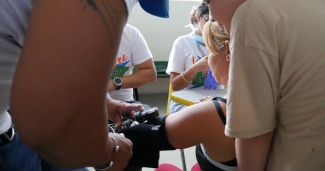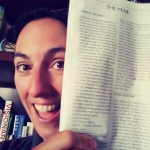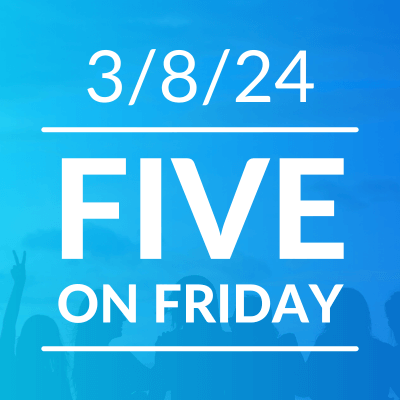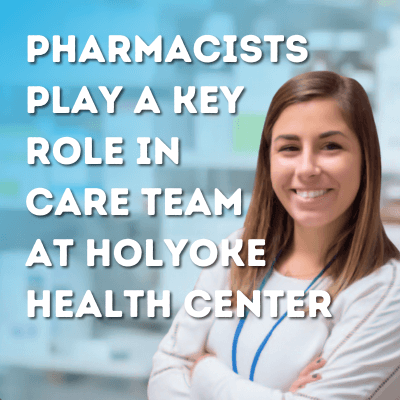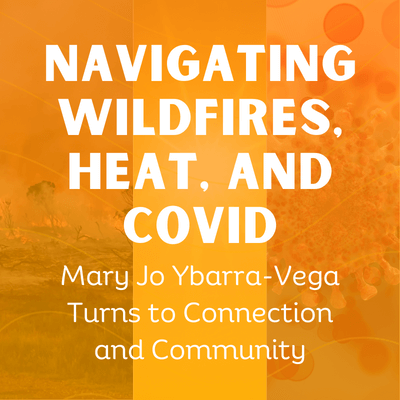New Streamline Article: Hypertension During Disasters -- Lessons from Puerto Rico

(Photo by CSM)
[Editor’s Note: The fall issue of Streamline has reached mailboxes around the country! In this issue, we cover a medical-legal partnership in California that helps pregnant agricultural workers assess their options of medical leave to avoid pesticide exposure. We also learn about how clinicians are addressing their trauma and avoiding burnout by taking the “witnessing” approach when working with traumatized patients. Here, in this Streamline reprint, we see how one health center in Puerto Rico managed patients with hypertension during Hurricane Maria, and how health centers can prepare for disasters by talking with patients and growing community awareness. Read the complete issue, subscribe to receive a printed copy of Streamline in your mailbox, and read our back issues on our Streamline webpage.]
“A patient had a stroke due to uncontrolled hypertension because his hypertension was untreated for two weeks and he was in continual stress. In this case, the doctor documents the cause of death as a stroke. But, when we consider the hurricane as the cause of stress and the reason he was unable to take his medicines, then this death should be related to the storm.” -Dr. Jose Rodriguez
One year ago, Hurricane Maria crumpled Puerto Rico’s infrastructure for months to come. Many homes were without power for over six months. Water systems were devastated and residents turned to local springs for drinking water. Transportation came to a stand-still. Without passable roads, food deliveries didn’t reach grocery stories. Workers in agriculture suddenly had no jobs, as the fields had blown away. With communication systems knocked out -- even cell phones weren’t working in many parts of the island -- Puerto Rico was left in the dark.
Facing this terrifying post-Maria situation were thousands of Puerto Ricans in rural communities with chronic conditions like hypertension. Under typical conditions, hypertension can already be a challenging health concern to manage. After Maria, for many, it was almost untenable.
“Hurricane Maria affected patients with hypertension in different ways,” explained Jose O. Rodriguez, MD, MCN’s Senior Medical Advisor for Puerto Rico, and Family Medicine Specialist and Medical Director of Hospital General Castañer, a community health center located in the center of Puerto Rico. At this health center, 26 percent of all patients have been diagnosed with hypertension – and many of them struggled after Hurricane Maria because of overlapping barriers to maintain their treatment plans. Damaged medication was particularly dangerous. “Some lost their medications [in the storm] and there was no way to get cash because there was no electricity for ATMs, no passable roads, and no gasoline available for vehicles. Without cash, patients could not buy their medications or pay their deductibles. The pharmacy had no ability to bill the medical plan and consequently they did not send their medications.”
To overcome these massive hurdles, Hospital General Castañer stepped into action. “On the fourth day after the hurricane, we began to visit the affected areas to evaluate patients and begin to deliver medication. In addition, our pharmacy opened its doors to patients and began to sell or advance medication to patients who had lost them [in the storm].” While supplies ran dangerously low, Dr. Rodriguez said that “no one was left without medication for not having money or a medical plan.”
Two weeks after the hurricane, medical supplies began to trickle in. For many, it was too late. The hurricanes resulted in thousands of deaths. According to a Harvard University study published in the New England Journal of Medicine an estimated 4,645 excess deaths occurred from September 20, 2017 to December 31, 2017.[1] Many of these deaths were the result of chronic health conditions turning deadly after the cut-off of access to food, water, electricity, and medicine, and coupled with toxic stress.
More than Medicine: Standard Approach to Hypertension Not Applicable After Maria
Hypertension is typically addressed through diet, exercise, the cessation of smoking and drinking, and vigilantly administered and regularly adjusted medication. Most of these approaches were compromised after Hurricane Maria, Dr. Rodriguez noted. Fresh food quickly ran out in stores, as transportation slowed food deliveries and farms were wiped out, so patients with hypertension turned, like the rest of the island, to canned foods and emergency foods provided by the Federal Emergency Management Agency (FEMA), or food still available in markets, most of which were high in salt and sugar. Directly after the storm, with houses lacking roofs and electricity and roads swept away, few had exercise on their minds, or the infrastructure to even go safely on a walk around the neighborhood. Most critically, noted Dr. Rodriguez, toxic stress played a significant factor in increasing the health risks associated with hypertension.
“The emotional destabilization caused by the hurricane resulted in [patients’] inability to have control over their hypertension,” Dr. Rodriguez emphasized. The stress produced by the loss of relatives, in addition to electricity, houses, medicines, and communication “placed all patients with chronic conditions – those with hypertension and those without -- at risk of losing control of those conditions due to their emotionally compromised state. The lack of communication (no radio, no television, no newspapers, no cell phones) caused an additional increase in stress,” Dr. Rodriguez added.
A New Approach
After Maria, Dr. Rodriguez and his crew -- both in the hospital and among the outreach workers going directly to patients in the community -- had to reevaluate the needs of patients with hypertension, and retool their approach. Their main strategy was to educate patients, emphasizing the importance of stabilizing their blood pressure.
“After the hurricane, our approach to patients with hypertension became more aggressive around education on diet, hydration, pressure monitoring, and the use of medications to control blood pressure and chronic conditions overall,” he said. “Most patients even with uncontrolled hypertension may not have acute symptoms, but chronic uncontrolled hypertension causes damage to the cardiovascular system. In many patients, the first sign is a stroke, heart attack, brain hemorrhage, or heart failure. The patient must be shown how important it is to control their blood pressure to avoid these complications.” (Read some of Dr. Rodriguez’s solutions in the accompanying text box.)
Immediately after the hurricane and regularly since then, mental health has been a foremost concern. Dr. Rodriguez recognizes that his patients are still reeling from Maria. “The effects of Hurricane Maria are still lasting in the minds of patients. This hurricane season, any news of changes in the weather induces stress in patients, and many go into despair,” he noted.
Looking Ahead: Preparing the Team for the Next Disaster
The changing climate weighs heavily on Dr. Rodriguez, who recognizes that long-term strategies must take into account the increasing risk and regularity of such major weather events. Education continues to be essential. “We are improving our education on monitoring at home, on alternative diets, and on the use of medication depending on their blood pressure readings,” Dr. Rodriguez stated. His team is instructing all patients to store their medication in sealed Ziplock bags, and spreading the word that pharmacies typically only have two weeks’ supply on hand.
To get the word out, Hospital General Castañer has engaged staff from all levels to take part in the educational effort. Doctors, pharmacists, and promotores de salud provide patients with education after their appointments, while they wait in the waiting room, and at health fairs in popular community locations. The outreach program has expanded its coverage area, and the health center has expanded the available hours of its psychologist, social workers, and rehabilitation counselor in three clinics. A new monthly program has been launched to bring patients with hypertension together for further support, collaboration, and education. And new partnerships are forming, including a partnership between the local supermarket and the nutritionist. The hospital is also running regular educational announcements on local radio.
[1] Kishore N, Marqués D, Mahmud A, et al. Mortality in Puerto Rico after Hurricane Maria. N Engl J Med. 2018;379(2):162-170.
Hospital General Castañer Strategies
A summary of the approach that Dr. Rodriguez and his team have implemented to best serve patients with hypertension.
Health center staff can help patients manage chronic stress and other mental health concerns after a disaster:
Help patients attempt to return to a level of normalcy in their lives.
Encourage them to reactivate their social circles.
Provide guidance on resources to address their mental state, including therapy.
Prescribe appropriate medications for those struggling with stress, anxiety, and depression as needed.
Keep the community informed. Make communication a key part of the outreach team’s job. Rumors and misinformation spread fast, especially when official avenues of communication like radio and the internet are down, and the outreach team has a unique and important role to combat misinformation.
Continue to make available and promote mental health resources, even after the community has begun to rebuild; mental health concerns may not be uncovered until months after the disaster.
Patient education is key.
Remind patients that:
A healthy lifestyle is their best bet to combating hypertension.
Drink sufficient water.
Limit your salt intake by paying attention to available foods and choosing your best options.
Exercise daily, despite the disruption in day-to-day life.
Do your best to eat within the confines of the recommended DASH diet (the Dietary Approach to Stop Hypertension, which emphasizes whole grains, fruits, vegetables and low-fat dairy products), even when foods are less available like after a disaster. Emphasize low-carb and plant-based foods.
Know your rights. The Rehabilitation Act of 1973, section 504 notes that federal organizations providing financial and other assistance must make reasonable accommodation for those with disabilities.
Take care of wounds and scrapes to avoid infection.
Learn about and take care of co-infections and concurrent disease. For people with hypertension, this is particularly critical with those who also suffer from diabetes or dyslipidemia.
Prepare for the next disaster:
Make sure you always have a month’s worth of medications on hand.
Store your medicines in a waterproof plastic bag.
Make sure you know your medical history and your course of treatment.
If you require dialysis, keep an emergency food kit ready that suits your dietary needs.
Ensure that your medical devices are always charged.
Many patients are unable to pay for even the current month’s supply of medications; others struggle to have enough food on the table.
Consider providing samples, collaborating with a local organization to raise money for emergency medicine costs, and connecting with local food pantries to help low-income patients actualize this preparation list.
Like what you see? Amplify our collective voice with a contribution.
Got some good news to share? Contact us on our social media pages above.
Return to the main blog page or sign up for blog updates here.
- Log in to post comments
